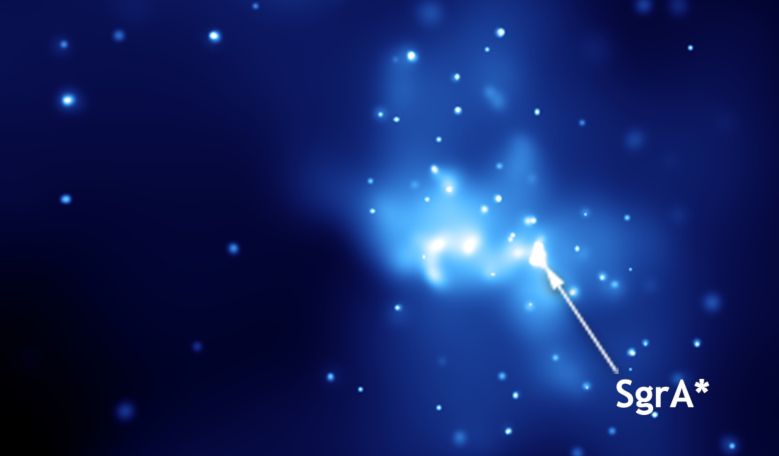The dark destroyer at the centre of our galaxy, our resident black hole known as Sagittarius A* (Sgr A* for short) is usually a quiet inhabitant. But recent observations with the Keck telescope have showed a big increase in activity suggesting that it could be waking up. Either that or a recent meal has given it major gassy indigestion.
Sgr A* is classed as a supermassive black hole (SBH) and being the nearest one to us, it has been extensively studied across many wavelengths of light, from gamma waves down to radio waves. In fact it was a beam of radio wave emission in 1931 that first drew astronomers attention to the invisible void that sits in the Milky Way's innermost region, 26,000 light-years away in the direction of the constellation Sagittarius. It would be over 40 years later however before more concrete evidence of its existence was published.
Since then it has been observed countless times and for the last 20 years, the W. M. Keck Observatory, a twin-telescope observatory that sits near the summit of Mauna Kea in Hawaii, has been casting its infrared eyes over the SBH on a regular basis.
Although Sgr A* is described as dormant, observations of antiquated X-ray light (affectionately known as light echos) coming from excited iron atoms suggest that the usual quiescent SBH has undergone bursts of activity in the past few hundred years.
More recently, a star known as S2 got within 100 AU (astronomical units) of Sgr A*, giving astronomers the chance to test relativistic effects predicted by Einstein’s equations (the test worked and S2 behaved exactly as relativity predicted). But other than that, reports of feverish excitement are few and far between.
That could soon change, as an international team of astronomers have reported that Sgr A* has, this year, been brighter than ever when measured at near-infrared wavelengths - over twice as much as previously observed by Keck. Data gathered by Keck coupled with measurements from the Very Large Telescope (VLT)
That could soon change, as an international team of astronomers have reported that Sgr A* has, this year, been brighter than ever when measured at near-infrared wavelengths.
Using data collected from 13, 000 measurements over 130 nights by Keck and the Very Large Telescope (VLT), the team have shown that Sgr A* has doubled in brightness compared with past values; activity that has persisted for longer than normal.
“This increase in brightness and variability may indicate a period of heightened activity from Sgr A* or a change in its accretion state,” say the researchers of a paper submitted to the ArXiv database, whose lead author is Tuan Do at the University of California, Los Angeles.
Could Sgr A* be gobbling up another star? Or could a nearby star just be shedding its outer layers making it look like the black hole was awakening? Some of the closest known stars, like S2, belong to the S- star cluster, a group of massive young stars that closely orbit our central SBH.
None are losing mass at a high rate, no obvious ones anyway, say the authors and as for Sgr A* feeling peckish, that is not clear either at this stage. It could be something as monotonous as how the gas is getting fed into the black hole. If its irregular, then its likely to be quite lumpy and variable and Sgr A* is just having a bigger meal than usual - one that will quieten down again in next to no time when its finished its clumpy-gas dinner.
“The major question is whether Sgr A* is showing increased levels of activity, and if so, how long it will last,” say Do and colleagues in their paper. A question that can only be answered with additional observations preferably ones that span a variety of wavelengths so that scientists can study the nature of Sgr A*’s current heightened activity.











